Part 1 of Modern Shrubs [Curtains]
[Enter stage right with slight swaying stagger, old age? Bushmills?]
Just when you thought it safe, here I am back with more on roses!
Rosefan has very eloquently and knowledgably walked us through
‘Hybrid Tea’, ‘Polyantha’, ‘Floribunda’, ‘Poly Pom’ and ‘Grandiflora’ .
There are other Modern Roses groups, and it is these that I will attempt to bring to you. I am aiming to cover
‘Shrub Roses’ (Musk, Austin, Ground Cover, et al) and
Climbers and Ramblers . I have included ground cover as nice thought but I believe, not a very practical one.
What is the difference between a shrub and a shrub rose, absolutely nothing? A shrub rose is just that, a shrub that happens to be from the family
Rosa , therefore it can be used as any other shrub. Some are once flowering, although most are repeat or continuous, so one up on most other shrubs, some are tall; some are short or even prostrate. Some are bushy in growth other will double up as either small climbers or tall shrubs. The real climbers we will look at separately. The quantity of
‘Shrub Roses’ available is legion. I will try to be unbiased in the pictures used to give a fair cross section.
Rosefan may have already, in part, covered some of the information or names I will introduce, for that I apologise. I include them for continuity.
Continuing on, chronologically speaking, from where we stopped in ‘Old Roses’. We are at or about 1900, and entering the world of
‘Shrub Roses’ . One Peter Lambert, a nurseryman from Germany, introduced a rose cultivar named
‘Trier’ . Its destiny was to be the forerunner of a new group of roses. Her parentage, like those of some ‘Old Roses’ is contentious, originally reported as a seedling of
‘Aglaia’ crossed with
‘ Mrs R G Sharman-Crawford’ . Some research has suggested that the union did not happen. So I am led to believe she is a seedling, or maybe a selfed seedling from
‘Aglaia’ . Now
‘Aglaia’ has
‘R.multiflora ‘ and
‘Reve d’Or’ as her parents. As I am sure you are fully aware the latter is a
‘Noisette’ , which has a strong
‘Tea’ influence as well as, in its distant past,
‘R.moschata’ .
 ‘Trier’
‘Trier’ 1904. Lambert. Dubious parentage. Erect shrub, or small climber, with small, near single flowers. Will get to 8 foot. Nothing really special to warrant space in the average garden but is important as a parent.
Her parents are;
‘Aglaia’ [/b]
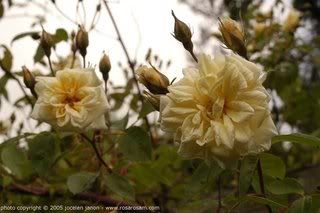
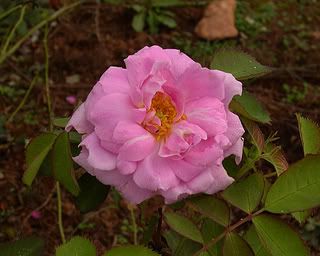 ‘Mrs R G Sharman Crawford’
‘Mrs R G Sharman Crawford’ Those plants introduced by Lambert were originally named
‘Lambertiana Roses’ before eventually being swallowed up by
‘Hybrid Musks’ . Here are a few more..
 ‘Lessing’
‘Lessing’ 1914
‘Trier x ‘Entente Cordial’ She will get to about 5 foot, what would you call that? a sort of rose/blush coloured small flower.
‘Heinrich Conrad Soth‘ 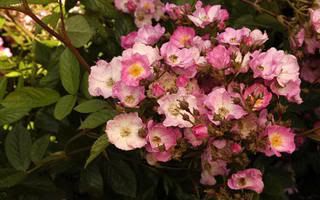
1919
‘Trier’ is in there somewhere possibly a grandparent. Growing to 6 foot or so, it’s a shrubby/rambler with large trusses of pink flowers that will repeat, also has good dark glossy foliage.
 ‘Excellenz von Schubert’
‘Excellenz von Schubert’ 1909 Another one for good foliage colour. She has small pink/crimson flowers that will repeat. She again could be used as a shrub or small climber.
The above ramblings on parentage was to show you just how little
‘Musk Rose’ there is in
‘Trier’ . Be that as it may, the group that she, or a close relative, was the main seed parent, is for some perverse reason called
‘Hybrid Musk’ . Their parentage from
‘Trier’ backwards, will contain all types of garden roses. The actual crosses that produced them would be mainly
‘Hybrid Tea’ as the pollen parent. So you can see they are a very mixed bag and the group title is somewhat far fetched, but there again, no more than say
‘Noisette’ , which is how they are known on the near continent.
 ‘Autumn Delight’ (Hybrid Musk)
‘Autumn Delight’ (Hybrid Musk) 1933. All but prickless, dark green foliage, apricot buds opening to a creamy yellow single flower, grows to approx 5 foot.
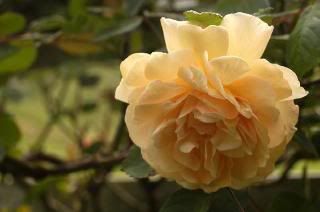 ‘Buff Beauty’ (Hybrid Musk)
‘Buff Beauty’ (Hybrid Musk) 1939 This one was by Bentall and possibly his best. The flowers are an apricot yellow, fully double, in early flower they are borne singly or in clusters. The later flowers, midsummer to autumn, tend to be in panicles. She has a lot going for her. In addition to those flowers, her young stems and foliage are bronzed. Her scent is very
‘Tea Rose’ and those flowers when in bud, are tinted coral. Ah yes, nearly forgot she will grow to about 6 foot.
Nevertheless, many good examples of garden shrubs have come from these lines and from several sources. They have, strange though it may seem, enough horticultural similarities to put them in the same group. Most of them have a good fragrance. This would come from
‘Trier’ , which in turn would have acquired it from
‘R.multiflora’ .
‘Hybrid Musk’s’ have the ability to fill the still, summer evening air with their scent.
I found this for the romantics.
”But above all the Musk,
With classic names, Thisbe, Penelope,
Whose nectarous load grows heavier with the dusk,
And like a grape too sweetly muscadine.”
The mixture of
‘Hybrid Musk’ with say, a Mock Orange can be very heady indeed; the white of the “philly” will also sit comfortable with any grouping of
‘Shrub Roses’ . Of which the
‘Hybrid Musk’ is a fine example.
‘Trier’ was one of a half dozen or so plants that Lambert raised between 1900-1922’ish. As said previously at one point they were known as
‘Lambertiana Roses’ , their flowers were small and recurrent. They would be best described as loose bush or small climber/pillar rose. Of those Lambert roses I can only find
‘Trier’ in any current catalogue, even then listed as a rambler, when really she should be classed as a
‘Hybrid Multiflora’ , either way, they were a useful step along the way to
‘Hybrid Musks’ and beyond!
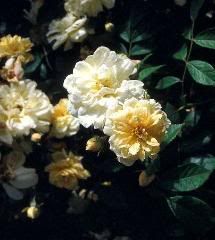 ‘Thisbe’ (Hybrid Musk)
‘Thisbe’ (Hybrid Musk) 1918, Pemberton, a cross between
‘Marie Jeanne’ (Polyantha) x ‘Perle des Jardins’ (‘Tea’) . Very pronounced musk fragrance, semi double ”rosette” style flowers of yellow fading to a mellow buff with good stamens. Grows to about 4 foot up and across.
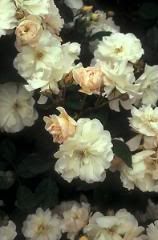 ‘Penelope’ (Hybrid Musk)
‘Penelope’ (Hybrid Musk) 1924, Pemberton, a cross between
‘Ophelia’ (HT) x unknown. Seedling Another plant with a good fragrance, will normally attain 5 foot or so and produce flowers in clusters. The flowers are a soft pink fading to near white in sunshine. The repeat flowers will appear in trusses. She is a very good bed partner for Ceanothus, in any hue from light – dark blue, or similar blue shrubs.
‘Hybrid Musks’ are a healthy group of
‘Shrub Roses’ , they have an endearing and lasting beauty, which is worthy of your perusal. Yes I know they are not Old Roses, but age alone does not make a good rose!
They produce blooms in very large clusters that are both fragrant and recurrent. It is said that deadheading will stimulate autumn repeat flowering, but left alone you can still expect them to flower from spring to autumn. Many produce heps, generally quite dainty. Some will climb if given the chance, most will grow to 5-6 foot. So are not out of place anywhere in the garden. You could use them as shrub/climbers, where they would provide cheerful background colour. As shrubs they look good in a mixed border or as specimens, you could also use them as freestanding hedges. They fill the colour spectrum from soft pastels to startling vibrant scarlet.
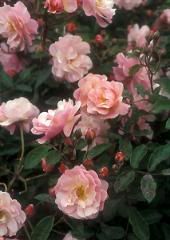 ‘Cornelia’ (Hybrid Musk)
‘Cornelia’ (Hybrid Musk) 1925, Pemberton. Parents unknown, having said that it does not take a trained eye to spot the “class” characteristics so
] ‘Trier’ is there somewhere! A somewhat vigorous, medium shrub to some 8 x 5 feet. Has good shiny foliage. The earlier flowers of a soft yellow fading pink seem to be smaller than those which appear later in the season.
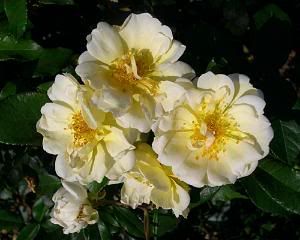 ‘Daybreak’ (Hybrid Musk)
‘Daybreak’ (Hybrid Musk) 1918, Pemberton. Parents are
‘Trier’ x ‘Liberty’ (Hybrid Tea). She has brown stems and stalks, with dark ruddy/brown foliage. Her flowers are a light yellow and nearly double with prominent golden stamens. A good musk scent and all on a plant that will get to about 3-4 foot.
 ‘Nur Mahal’ (Hybrid Musk)
‘Nur Mahal’ (Hybrid Musk) 1923, Pemberton. From a cross between
‘Chateau de Clos Vougeot’ (Hybrid Tea) x unknown Seedling ‘Hybrid Musks’ are the product of the toil of one Rev Joseph Hardwick Pemberton, who developed them in his garden in Havering-atte-Bower, Essex. They were a mixed group and assuming his notes were correct, it is difficult to see any defined plan or target, apart from a good shrub. He did seem, however, to have a high regard for scent in his plants. The Rev produced some 2 dozen plants, based mainly on
‘Trier’ . These being brought to market by Bentall. Of these 15 or so are still in cultivation, with only 9 being in the forefront of
‘Shrub Roses’ or, as some say, shrubs in general. After the Rev had joined the “choir invisible”, Bentall continued the work by raising a half a dozen or so new shrubs, of which perhaps only 2 are still in cultivation. It is probably fair to say that the work of these two hybridisers was not appreciated at the time, with the few excellent examples being lost in the “dross” (or you could use the wheat/chaff or Swans/Geese comparisons). This coupled with the popularity, at the time, of
Hybrid Tea and Polyantha style roses, meant that the
Hybrid Musk did not really find a home in the modern garden of that era nor many if any catalogues of the period.
It may, or maybe not, surprise you. I have one in my present garden and very pretty she is too!
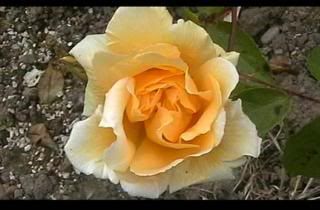
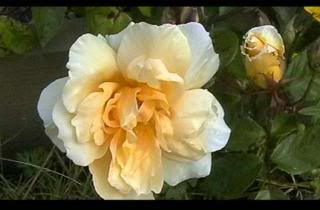
Both are my
‘Francesca’ (Hybrid Musk) taken in my garden. See, told you she was pretty. Introduced in 1922, by Pemberton. The result of a cross between
‘Danae’ (Hybrid Musk) x ‘Sunburst’ (Hybrid Tea) She has dark ruddy/brown shoots and prickles, with dark green leaves. The flowers you can see for yourself are quite endearing. You can see the
‘Tea’ influence in her leaves, growth habit and sometimes the scent. She should be quite hardy despite the
‘Tea’ influence, but mine is suffering at the moment and you know my pragmatic approach to that situation.
As intimated above, the Rev’s work was before its time, as it was not until around the 50’s (1950’s that is) that Shrub Roses, which is what I believe he was aiming at, started to increase in popularity. They became a useful shrub in the border with their colour and fragrance. Their flowers would arrive in July, just as the
Old Roses are turning over and so be in time to compliment the other summer flowering shrubs. To extol their virtues further, in winter they will also add some colour to the winter border via their heps.
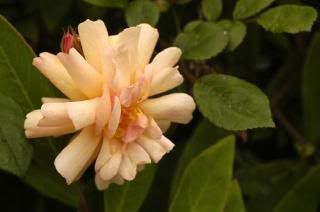 ‘Clytemnestra’(Hybrid Musk)
‘Clytemnestra’(Hybrid Musk) , 1915, Pemberton
‘Trier’ x ‘Liberty’ (Hybrid Tea) Yes the same parents as
‘Daybreak’ and I know which I prefer I cannot get used to those petals. She has copper/salmon buds opening to those yellow crinkled petalled flowers. Will get to 3-4 foot as a spreading bush!
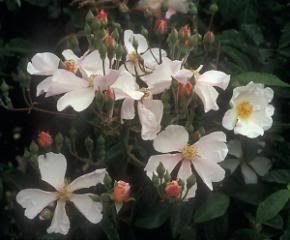 ‘Kathleen’(Hybrid Musk)
‘Kathleen’(Hybrid Musk) 1922, Pemberton from a cross between
‘Daphne’ x ‘Perle des Jardins’ (Tea) . Downside first, she will suffer from rain spotting on petals. Other than that quite a good shrub having the characteristic coppery tint to leaves and stems. She carries her flowers of pink in long clusters, she will grow to around 3 foot all round, so good as a filler or for the front if you like those flowers!
These next two are not only from a different breeder but also from the same parents and may even be sibling seedlings, if there is such a thing, but I am sure you understand what I am waffling on about.
The breeder was Kordes, I suspect Wilhelm II, given the dates. The cross used was
‘Robin Hood’ (Hybrid Musk by the Rev 1927) x ‘J C Thornton’ (Hybrid Tea). ‘Eva’(Hybrid Musk)
‘Eva’(Hybrid Musk) 1933. She appears not to have a great following as a garden plant. Without getting too technical she was a tetraploid and therefore very popular as a parent rather than her garden worthiness. Her single flowers are carried on stout stems and she gets to about 6 foot. She is very close to a
Floribunda , which may account for lack of popularity.
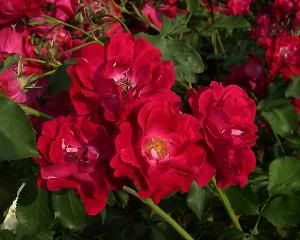 ‘Wilhelm’(Hybrid Musk)
‘Wilhelm’(Hybrid Musk) 1934 She again is a tetraploid and heavily into breeding. She can be a bit vigorous and showy she will get to 6 foot all round, maybe larger. Very little scent, with flowers of an “old” colouring, crimson edged plum. They are semi double, opening from dark, near black buds, are borne in trusses and fade to a dark crimson-mauve. If you have both “old” and “new” then this is the plant to use as a physical link between the two. Also good as a Pillar Rose.
From now on we are looking at roses that have no direct connection to that other group
Old Roses most would be the result of deliberate breeding. En passant, it is interesting to note that, the most prolific of seed and pollen parent connected with most of them is
R.rugosa [/b]. The group we so broadly call
Shrub Roses are so diverse in character and varied in content that it is possibly best to look at them in “like for like” groups. That is to say how they grow rather than botanical. Well at first anyway.
There is a group of once flowering. These are mostly soft pinks and or white, as such will sit comfortably with
Old Roses . The following are good in a wild/nature area or scrambling over things. Often included in here are hybrids from
R.macrantha viz
‘Daisy Hill’, ‘Harry Maasz’, ‘Raubritter’, ‘Lady Curzon’ and
‘Max Graf’ , which you may have heard of as a “ground cover”, given her dense sprawling growth.
 ‘Daisy Hill’
‘Daisy Hill’ Introduced by Kordes in 1906. Large single, pink flowers, mild scent; growing to 8 feet.
 ‘Harry Maasz’
‘Harry Maasz’ Introduced Kordes 1939 Parents are
‘Barcelona’ (HT) and ‘Daisy Hill’ above. Often called a crimson
R.macrantha . The flowers are carried along the trailing stems that can get to 10 feet or more in a single year. So good for climbing fences, trees, over small mounds or through other shrubs/hedges.
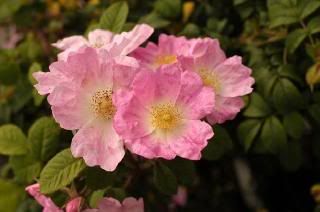 ‘Lady Curzon’
‘Lady Curzon’ Introduced by Turner, England, 1901. A very vigorous grower, so be warned if left to its own devices she will soon grow to a very tangled mound some 8 foot by foot, which the petty light pink single flowers would completely cover. She will also if “trained” grow into trees or through hedges and other shrubs. The NT use her at several locations and each time with a complementary rambler.
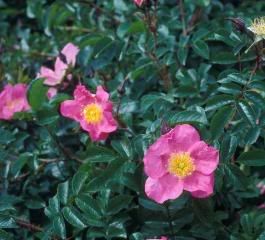 ‘Max Graf’
‘Max Graf’ Introduced by Bowditch, USA, 1919. Not a
’Macrantha Hybrid’ her parents are
‘Rugosa’ and R.wichuraiana It is best known as ground cover. She will produce a dense mat of growth no more than 2 feet high. She will increase in size using the same method as her close relative the humble “strawb” and is as invasive above ground as mint is underground, given time. Therefore also good for banks and walls. She has a botanical claim to fame; for many years she was “infertile”, you know my views on that! Then all of a sudden she produces tetraploid seeds, which have been used in several breeding programmes. Why would you keep checking a so called “infertile” plant for “fertile” seeds/seedlings??
Of the more substantial shrubs, most of which will descending from
‘Rugosa’ , we have the
‘The van Groots’ as I call them. Or to give them their correct names
‘F J Grootendorst’, ‘Pink Grootendorst’ and ‘Grootendorst Supreme’ . Other examples would be those
‘Hybrid Musks’ from above. There are many others that I could name like
‘Adam Messerich’, ‘Fritz Nobis’ and
‘Gypsy Boy’ aka ‘Zigeunerknabe ‘ . You’ll remember him from that little diversion into
’Rugosa’ on the other topic, in fact you could nearly include all of those
’Rugosa Hybrids’ here.
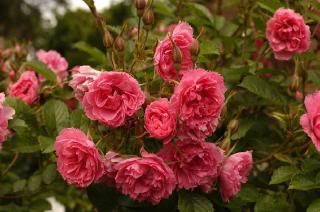 ‘Pink Grootendorst‘
‘Pink Grootendorst‘ Introduced by F J Grootendorst, 1923. She is a pink sport of
‘F J Grootendorst’ below
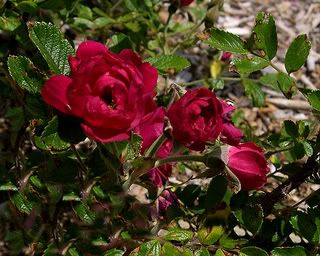 ‘F J Grootendorst’
‘F J Grootendorst’ Introduced by De Goey, Holland, 1918. Parents are
‘Rugosa rubra’ x ‘ Mme Norbert Levavasseur’ (Poly Pom) . Like all the Groots it has no scent, which many believe is their downfall. She will grow to 6 foot and flower continuous through to autumn.
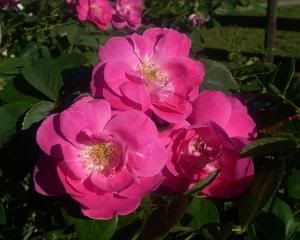 ‘Adam Messerich’
‘Adam Messerich’ Introduced Lambert, Germany, 1920. Parents, complex but here we go
‘Frau Oberhofgartner Schulze’ (Polyantha) x (‘Louise Odier’ (Bourbon) seedling x ‘Louis Philippe’ (China)) hope you followed that. As a result she is a good sturdy shrub with few prickles and semi double, cupped flowers. They are pink and will have a heavy first flush in summer and like “Aunty” a few repeats in the autumn. She will grow to 6 x 5 foot. Often classed as a
‘Bourbon’ which may be true but what’s in a name? It is still a shrub.
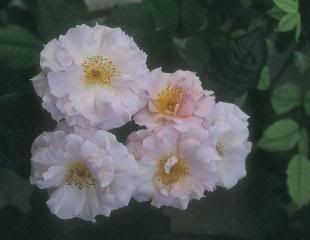 ‘Fritz Nobis’
‘Fritz Nobis’ Introduced Kordes, Germany, 1940. Parents
‘Joanna Hill’ (HT) x ‘Magnifica’ (Hybrid Rubiginosa) . She will grow to 6 foot or so. The flowers are semi double, clear two tone pink, some say a clove scent can be detected.
In this particular “grouping” there is one shrub,
‘Nevada’ , which stands head and shoulders above all others. In every meaning of the phrase
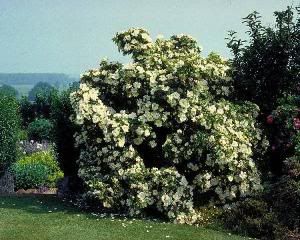
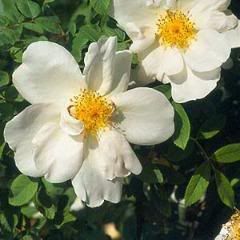 ‘Nevada’
‘Nevada’ Introduced by Dot, Spain 1927 Parents are
‘Giralda’ (HT) x R.moyesii Hybrid So, she should be classed as a
R.moyesii Hybrid and is probably exactly what you would expect from the genes of those parents. Those big arching branches with flowers along their entire length are from
‘Moyesii’ . I will not describe the flowers as you can see them, but they will get to 4-5 inches across. As a mature plant she can reach 10-12 foot in all directions, and as I am sure you can imagine when covered in flower is a splendid sight
Just thought of a couple more for this bit!
‘Aloha’ and for the back of the border, so you can hide her modesty, with some smaller shrubs or perennials, or even annuals try
‘Sarah van Fleet’ .
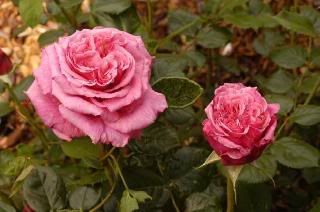 ‘Aloha’
‘Aloha’ Introduced by Boerner, USA, 1949. Parents
‘Mercedes Gallart’ (HT) x ‘New Dawn’ (Hybrid Wichurana) . That’s the modern way of saying
‘Hybrid Wichuraiana’ Why? No idea. She has very full flowers of a good rose pink with darker reverses and a hint of “orange” at the centre. She will repeat several times through to autumn and gets to around 7 x 4 foot of good sturdy upright growth. Oft classed as a
‘HT’ but she is too sophisticated for that so we will call her a shrub or you can train her as a Pillar Rose, she will not mind!
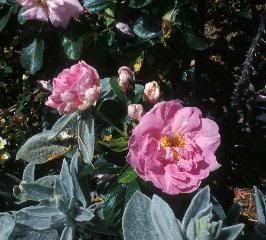 ‘Sarah van Fleet’
‘Sarah van Fleet’ Introduced by van Fleet, USA, 1926. Parents
R.rugosa x ‘My Maryland’ (HT) Classed as a
‘Hybrid Rugosa’ She has few peers that match her habit of producing a mass of very prickly upright stems. Ideal as a tall security screen or hedge or for planting at back of the border. Seemingly always in flower which gives a massed effect. The flowers are in clusters, with both the young shoots and leaves having a bronzed tint. She is a large shrub getting to 8 x 6 foot or so.
Next we have the early flowering, now the most famous here are the
‘Fruhlings’ . (I’ll not insult you with a translation, but it’s the season that precedes summer) Rosefan introduced you to a Herr Kordes, from Holstein, Germany. Well these are Wilhelm II’s babies, and very fine babies they are too. Wilhelm used
‘The Burnet Rose’ aka R.Pimpinellifolia or R.spinosissima as the pollen parent with various
‘Hybrid Tea’ , usually
‘Joanna Hill’ as the seed parent.
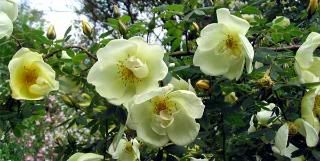
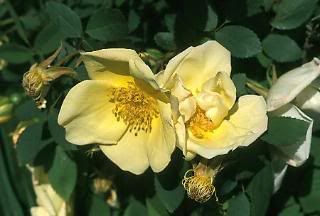 ‘Fruhlingsgold’
‘Fruhlingsgold’ Kordes, Germany 1937
‘Joanna Hill’ x R.pimpinellifolia ‘Hispida’ I’ll let the pictures tell their own story, all I will say is she will best any other shrub for charm, scent, growth and flowering, apart from, maybe, a hand full of
‘Species Rose’ . She will get to 6 x 6 feet

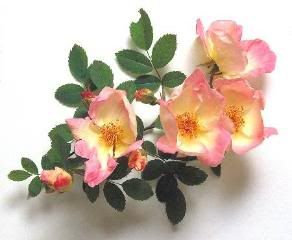 ‘Fruhlingsmorgan’
‘Fruhlingsmorgan’ Kordes, Germany, 1941.
(‘E G Hill’ (HT) x ‘Cathrine Kordes’ (HT)) x R.pimpinellifolia ‘Grandiflora’ . Again stunning, but I prefer single tones/colours. Having said that both of these are outstanding and a fine example of the breeder’s art and very close to perfection, if by luck or design is questionable, I’ll give him the benefit of the doubt. But there is only one breeder that achieves perfection by design
Here they all are in date order, I’ll not go into great descriptive detail on the pictures;
‘Fruhlingsgold’ (1937), ‘Fruhlingsmorgan’ (41), ‘-zauber’ (41), ‘-tag’ (49), ‘-duft (49)’, ‘-anfang’ (50) and ‘-schnee’ (54) This is my personal opinion now, and you may beg to differ, which of course is fine. The first two are the only ones to stand out; I would put
‘Nevada’ after
-gold but before
-morgan . But we are talking gnat’s whiskers here. Perhaps Rosefriend would provide the translation(s) if needed.
Now most of you will know that my preferred roses are
‘Old Roses’ or if really pushed then
‘Species Roses’ . So this is going to sound strange coming from me. I would not hesitate to put
‘Fruhlingsgold’ and ‘Nevada’ in my top ten of 5 petalled roses, with
‘Fruhlingsmorgan’ just outside. If it was Wilhelm’s plan to produce a most beautifully stunning shrub rose then he succeeded. You have heard me banging on about the fragrance of
Maidens Blush Great’ and how she fills the garden with her scent, well
‘Fruhlingsgold’ runs her a very, very close second.
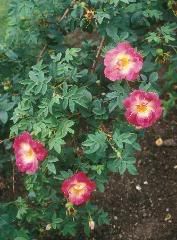 ‘Fruhlingszauber’
‘Fruhlingszauber’ Same parents as
‘-morgan’ But not close in any other way. Gets to 6 foot a bit of a sparse sprawling shrub.
 ‘Fruhlingstag’ ‘McGredy’s Wonder’(HT) x ‘Fruhlingsgold’
‘Fruhlingstag’ ‘McGredy’s Wonder’(HT) x ‘Fruhlingsgold’ possible the one with least garden merit, not even sure if it is still available.
 ‘Fruhlingsduft’ ‘Joanna Hill’ (HT) x R.pimpinellifolia ‘Grandiflora’
‘Fruhlingsduft’ ‘Joanna Hill’ (HT) x R.pimpinellifolia ‘Grandiflora’ . The only one that has a double, near
HT flower. Its biggest asset is one you cannot see; she has a very rich scent. Reaches 8 x 6 foot.
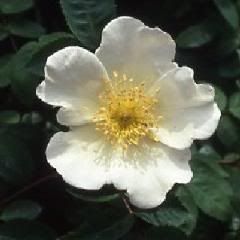 ‘Fruhlingsanfang’ ‘Joanna Hill’ (HT) x R.pimpinellifolia ‘Grandiflora’
‘Fruhlingsanfang’ ‘Joanna Hill’ (HT) x R.pimpinellifolia ‘Grandiflora’ . Very rich green shrub against which the flowers are displayed. One of the bigger examples and will get to 9 foot or so. Again a rich fragrance
 ‘Fruhlingsschnee’ ‘Golden Glow’ (HT) x R.pimpinellifolia ‘Grandiflora’
‘Fruhlingsschnee’ ‘Golden Glow’ (HT) x R.pimpinellifolia ‘Grandiflora’ . Strong fragrance. Once-blooming spring or summer. Wrinkled foliage. Growth 6 x 4
There are some
‘Hybrid Tea’ , that can be “classed” as
‘Shrub Roses’ I would use them as
‘Sarah’ above at the back of the border with other plants in front to cover the bare lower stems. I give you theses as examples.
‘ President Herbert Hoover’, ‘Buccaneer’, ‘Queen Elizabeth’ and ‘Helen Traubel’ 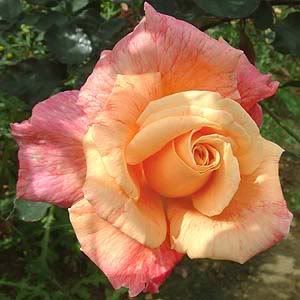 ‘President Herbert Hoover’
‘President Herbert Hoover’ Introduced by Coddington, USA, allegedly named on the day Hoover was elected as the 31 incumbent of that post and available 2 years later so that would be 1928 and 1930 respectively. Parents are
‘Sensation’ (HT) x ‘Souvinir de Claudius Pernet’ (HT) . The flowers are double and a typical class shape, the colour is a mix of orange, rose and gold lighter on reverse, The shrub will get to 6 foot or so,
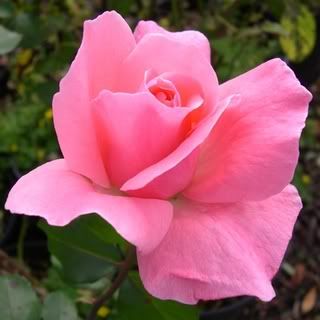 ‘Queen Elizabeth’
‘Queen Elizabeth’ Introduced 1954, to celebrate the accession of Elizabeth II in 1952, by Lammerts, USA. Parents are
‘Charlotte Armstrong’ (HT) x ‘Floradora’ (Floribunda) Flowers again are typical of the class, has been known to get to 8-10 foot and 5 foot across, although 6-8 is more likely. Flowers in flushes through season.
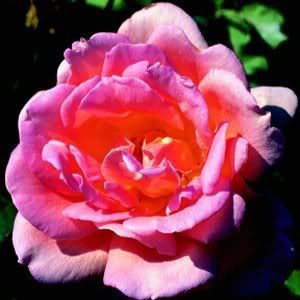 ‘Helen Traubel’
‘Helen Traubel’ Introduced by Armstrong circa 1953, bred by Swim 1951, USA. Parents are
‘Charlotte Armstrong’ (HT) x ‘Glowing Sunset’ (Hybrid Foetida/HT), whatever that is! Grows to 6 foot or so and flowers in flushes through season.
All will answer to
‘HT’ but strictly speaking
‘Queen Elizabeth’ is an example of
‘Grandiflora’ , only fitting really for one so named
“Ground Cover” , some of the early contenders namely
‘Max Graf’ and ‘The Fairy’ would have been happy accidents, the latter is sometimes listed as a
‘Polyantha’ , so what’s new! Latterly there has been work on purpose bred ground cover plants to wit
‘Grouse’, ‘Pheasant’, ‘Partridge’ and ‘Snow Carpet’ . I would also include
‘Dapple Dawn’ and ‘Red Coat’ . As previously stated, I am not convinced re roses as ground cover. I could not imagine a more painful task, than that of weeding through a prostrate rose. Particularly if like me you cannot work in gloves.
 ‘Grouse’
‘Grouse’ Introduced by Kordes, Germany, 1983. Parents are
‘The Fairy’ (Polyantha) x seedling of either (R.luciae or R.wichurana or R.wichuraiana.) depending on which nomenclature you follow. She has a lax spreading growth getting to about a foot high with a spread of around 10 foot.
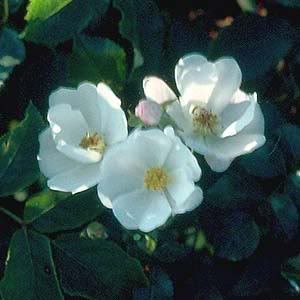 ‘Partridge’
‘Partridge’ As
‘Grouse’ save colour, so same breeder and parents.
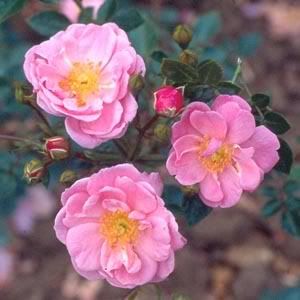 ‘Pheasant’
‘Pheasant’ Kordes, Germany, 1986, Similar in growth pattern to others in series but for some reason this is classed as a miniature. For parentage substitute
‘Zwergkonig 78’ for ‘The Fairy’ to save me typing all that nonsense again.
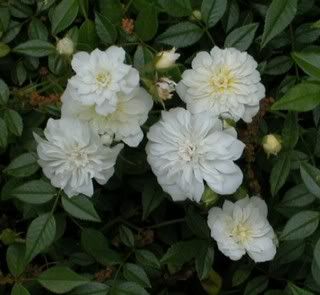 ‘Snow Carpet’
‘Snow Carpet’ Researching this little soul gave me a few smiles or where they grimaces. Bred by Samuel Darragh McGredy IV and introduced by McGredy Roses International 1980. It has an American patent!! McGredy is therefore its “inventor”! Perhaps moving from NI to NZ has something to do with it. Anyway back to reality the parents are
‘New Penny’ (Miniature) x ‘Temple Bells’ (miniature) . This is the smallest in height only getting to 8 inches with a spread of 4 foot or so.
There are many, many more that I could show you the choice is legion. If you’ll excuse me, I give you a flavour and I’ll try not to pick all the ones I like! You’ll find a couple of Austin but these are pre “English Roses”.
 ‘Martin Frobisher’
‘Martin Frobisher’ Introduced by Dr Svejda of something called Agriculture Canada,(Experimental Farm) Ottawa in circa 1961. She is a
‘Rugosa Hybrid’ , one of a group of 18 or so, called “Explorer Series”. Very disease resistant and hardy down to an alleged –40C. Grows to 6 x 4 foot with repeat flowerings. She is a seedling from
‘Schneezwerg’ 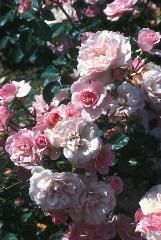 ‘Bonica’
‘Bonica’ A Shrub rose introduced by Meilland in 1985. Sometimes class as
‘Floribunda’ . We will call her a shrub, flowering almost continuously, mid pink at the centre lighter towards the edge. . Parentage:
(R.sempervirens x 'Mlle Marthe Carron’ (Hybrid Wichurana)) x 'Picasso' (Floribunda) . May get to 4 x 6 foot.
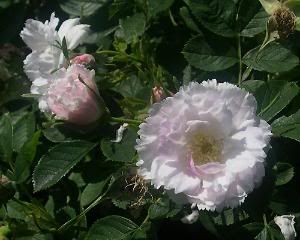 ‘Fimbriata’
‘Fimbriata’ Introduced by Morlet, France 1891 Parents are
R.rugosa x ‘Mme Alfred Carriere’(Noisette) . There appears to be more
‘Rugosa’ than the other parent. If you think it looks like a carnation then you are not alone cos one of its other names is
R.rugosa.dianthiflora It is what I would cal a “fussy/pretty” flower. They are not very double, with shorter petals at the centre; all petals are serrated or “frilled” at the edges. She will get to about 5 x 5 foot and hardy down to –30C. In fact she will do better in cooler climes, rather than warmer climes.
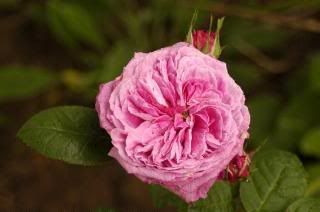 ‘de la grifferaie’
‘de la grifferaie’ Introduced by Vibert, France 1846. It is a
‘Multiflora Hybrid’ but pollen parent unknown. Hope you’ll pardon her inclusion here, only she does not fit in “Old” or “Climbers”. She is a tall shrub to some 8 feet or so. Her habit is a little sprawling with long whippy stems. The flowers are produced in clusters along those stems and are well scented. For many years she was used as rootstock only to out live the scions and produce a bonus shrub, so buy one get one free, several years later!!
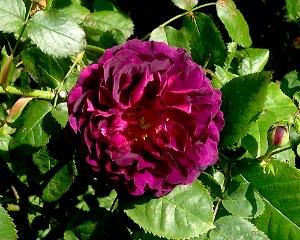 ‘Chianti’
‘Chianti’ Introduced by Austin England, 1961 Despite other references to the contrary, I am assured that the parents are
(R.macrantha x ‘Vanity’(Hybrid Musk) a medium sized shrub at 5 x 5 foot, with good foliage and growth pattern. A fragrant addition to the border.
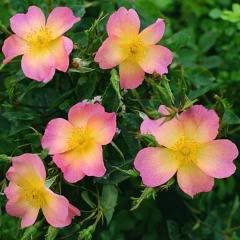 ‘The Alexandra Rose’
‘The Alexandra Rose’ Introduced by Austin, England 1993 I have taken the liberty of putting her here as is really a
‘Modern Shrub’ rather than an
‘English Rose’She will get to 4 x 4 and flower continuously through to autumn.
 ‘Cerise Bouquet’
‘Cerise Bouquet’ Bred by Tantau, introduced by Kordes, both from Germany 1937/1958. Parents
R.multibracteata x ‘Crimson Glory’ (HT) . The seed parent is responsible for the long arching branches of grey/green leaves. The flowers, on the other hand, are more from the pollen parent and borne in clusters and having a “sweet/fruity” scent. She will get to approx 9 x 12, so a medium/large shrub – small climber which flowers in the summer and repeats in the autumn.
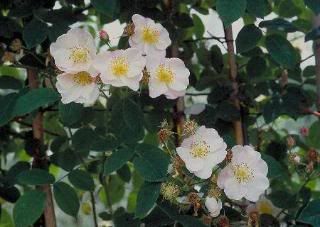 ‘Dupontii’
‘Dupontii’ Raised in the 1800’s by Dupont, he of Luxembourg Gardens fame and the one that built Josephines’ garden at Malmaison. I include her cos she is undoubtedly a shrub, not Modern I agree but only in date of conception! Surely you would not exclude her on that basis. Parents Very confused lets just say unknown. How’s this for a growth description; Arching, bushy, climbing, spreading, upright, well-branched growth habit. Medium mat, green foliage. 5 leaflets. Height of up to 7', width of up to 7’. So a medium shrub, of not a little beauty with the flowers as singles or in clusters along those arching growths and near prickle less.
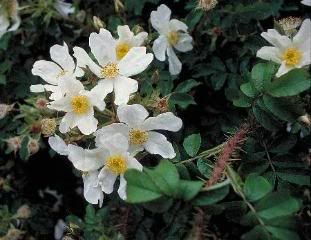 ‘Paulii’
‘Paulii’ Introduced by Paul, England 1903 Possible parents are
(R.rugosa x R.arvensis) x R.rugosa.repens alba) Another I debated whether to include or not, but someone out there may have the space and location for this all conquering specimen. She is very
‘Rugosa’ in flower and prickles
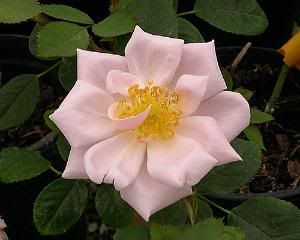 ‘Gabrielle Noyelle’
‘Gabrielle Noyelle’ Introduced Buatois, France, 1933. Parents
‘Salet’ (Moss) x ‘Souvinir de Mme Kreuger’ (HT) Strictly speaking she is a modern
‘ Hybrid Moss’ . She is very free flowering and being a small/medium shrub will get to about 5 x 4 foot. Single spring/summer flushes of bloom, with an occasional repeat in autumn.
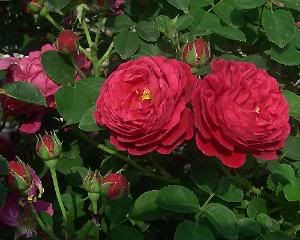 ‘Gypsy Boy’
‘Gypsy Boy’ Bred, Geschwind, Hungary, 1909 Introduced Lambert Germany 1909. Possibly a descendant of
‘Russeliana’ (Multiflora Hybrid) . She makes a dense graceful shrub of 5 foot and considerably, if not twice, wider, the stems are prickly and arching and along with the leaves are in the style of
‘Rugosa’ . She will flower one a year, in clusters along the stems.
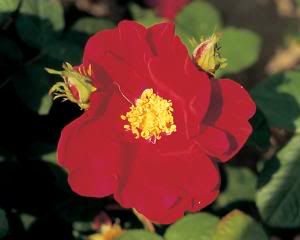 ‘James Mason’
‘James Mason’ Introduced by Beales, England, 1982. Parents
’Scharlachgkut’ (Gallica) x Tuscany’ (Gallica) . As you can see both are
‘Gallica’ , so in my eyes a good shrub, but it would have been regardless as long as it looked the same. She is a neat mid border shrub getting to 5 x 4 feet.
 ‘Karl Foerster’
‘Karl Foerster’ Introduced Kordes, Germany 1931
‘Frau Karl Druschki’(HP) x R.Pimpinellifolia ‘Grandiflora’ . Strange choice of bedfellows! She make a strong growing shrub, which in good condition will get to 5 x 4 foot. She does however inherit her mothers’ lack of scent.
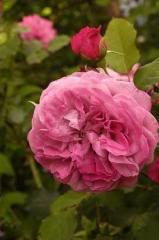 ‘Magenta’
‘Magenta’ Introduced Kordes, Germany 1954 Parents
Unknown Floribunda seedling x ‘Pink Pinocchio(Floribunda) So you would think she is a
‘Floribunda’ , lets just say we will call her a shrub. She will get to 4 foot, she has clusters of flowers a la
‘Floribunda’ , as you can see they are in
‘Old Rose’ style but want you cannot see is the delicate Myrrh scent.
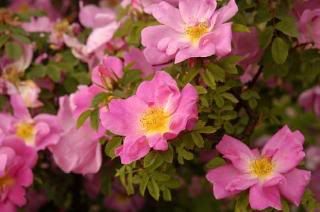 ‘Marguerite Hilling’
‘Marguerite Hilling’ Introduced Hilling, England, 1959. She is a natural sport from
‘Nevada’ , only this time pink. She appeared for the second time in 1959, having appeared previously in 1954. The same coloured sport also appeared in NZ in 1958. All aspects are as parent
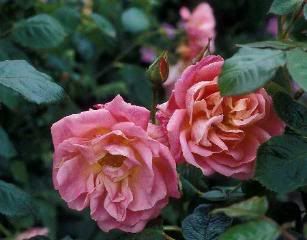 ‘Nymphenburg’
‘Nymphenburg’ . Introduced by Kordes, Germany, 1954. Parents
‘Sangerhausen’ (Hybrid Musk) x ‘Sunmist’ (Floribunda) . She is not happy as a shrub so best used as a small climber to about 10 foot. The leaves are large, glossy and dark green. The flowers have a “apple” scent, I am told.
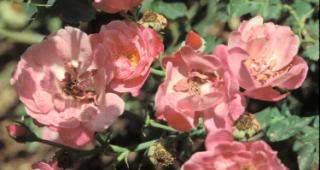 ‘Sophie’s Perpetual’
‘Sophie’s Perpetual’ And that’s all that is known about her. She is a poor orphan foundling and named by one Humphrey Brook (?) You can grow her as a medium/large shrub to 8 foot or as a climber to about 15 foot.
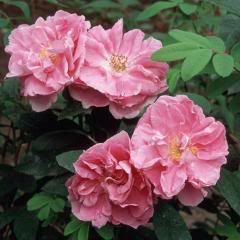 ‘Theresa Bugnet’
‘Theresa Bugnet’ bred by Bugnet, and introduced by Wright, Canada, 1950. A very complicated parentage, but here goes. The seed parent was an unnamed seedling from the following
(R.acicularis x R. rugosa. kamschatica) x (R.ambiyotis x R.rugosa. plena) this was then crossed with the pollen parent
‘Betty Bland’ Lots of
‘Rugosa’ in there which may well account for her hardiness and as she grows quite happily in N Alberta she needs to be hardy. She will get to 6 foot or so and shoots may well get to that length in a single season, has a strong fragrance.
Part 2 below
